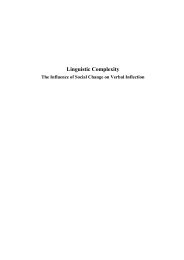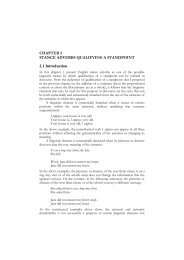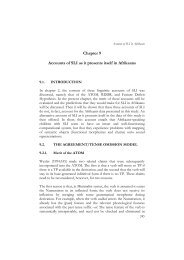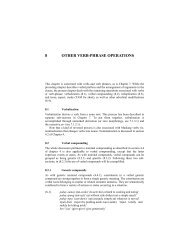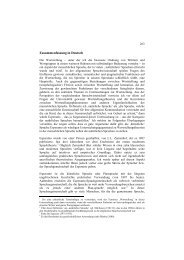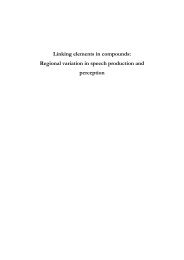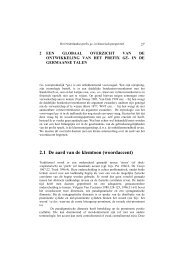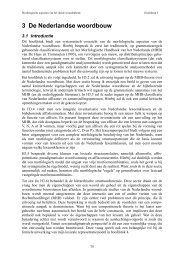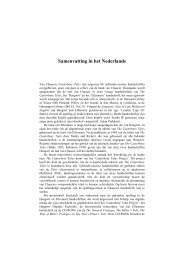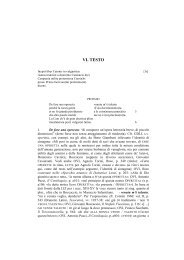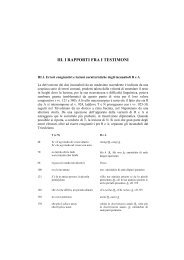Chapter 3 The Dutch Situation - LOT publications
Chapter 3 The Dutch Situation - LOT publications
Chapter 3 The Dutch Situation - LOT publications
You also want an ePaper? Increase the reach of your titles
YUMPU automatically turns print PDFs into web optimized ePapers that Google loves.
<strong>The</strong> <strong>Dutch</strong> <strong>Situation</strong><br />
<strong>The</strong> issue will be revisited in <strong>Chapter</strong>s 5 and 6, where the corpus data is presented<br />
and discussed. This masculinization has opened the doors to a movement in the<br />
opposite direction, viz. the promotion of the feminine pronoun to a marker of high<br />
style. For speakers from the north of the <strong>Dutch</strong> language area, it reflects the<br />
command of a distinction only marginally alive in the spoken language, but<br />
associated with educated writing. Thus, the feminine is the prime candidate for<br />
hypercorrect language use.<br />
Indeed, in some registers the feminine is overused to such an extent that it has<br />
attracted public attention. <strong>The</strong> popular term “haar-ziekte” (‘haar-disease’) was<br />
coined to describe the proliferation of the full-form feminine possessive haar ‘her’<br />
in unexpected places. This extensive use of haar can be attributed to language<br />
history on the one hand, on the other to hypercorrection and opportunism.<br />
<strong>The</strong> haar in question is used mainly in journalistic and administrative writing, and it<br />
appears preferably with collectives such as partij ‘party’ or volk ‘people’.<br />
Sometimes the antecedent is a true historical feminine, such as regering<br />
‘government’, but in many cases it is not. Haar is occasionally used for historical<br />
masculines such as staat ‘state’, and in fact, it is quite often found in combination<br />
with neuter nouns. <strong>The</strong>se are the cases against which the protest in the media is<br />
directed, and the relevant sentences are smiled at or frowned upon by native<br />
speakers of <strong>Dutch</strong>. Two examples are given under (13).<br />
(13) a) dat het Nederlandse volk haar soevereiniteit terug krijgt<br />
that DEF.N <strong>Dutch</strong> people(N) POSS.F sovereignty back gets<br />
‘that the <strong>Dutch</strong> people regains its sovereignty’<br />
(http://presscenter.nl/Message/default.asp?NewsID=763&CatID=100)<br />
b) Het ijshockey in Nederland probeert alles<br />
DEF.N ice_hockey(N) in the_Netherlands tries everything<br />
om haar imago te verbeteren<br />
in_order POSS.F image to improve<br />
‘<strong>The</strong> ice hockey in the Netherlands is trying everything in<br />
order to improve its image’<br />
(De Volkskrant 05 January 2004)<br />
<strong>The</strong> link to collectives probably has a historical source. In earlier <strong>Dutch</strong>, the form<br />
haar was used as a plural possessive form for all three genders (this place in the<br />
paradigm is now occupied by hun ‘their’) (Van der Sijs 2004: 448). This usage is<br />
still reported in the grammar of Ten Kate (Ten Kate, Noordegraaf and Van der Wal<br />
2001 [1723] I: 471). In Middle <strong>Dutch</strong>, many collective nouns, especially derived<br />
words, had feminine gender. Since collectives are often pronominalized by plural<br />
pronouns, a reinterpretation from a plural to a feminine pronoun is a likely path of<br />
development.<br />
48



